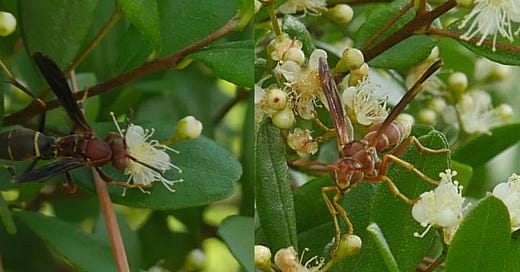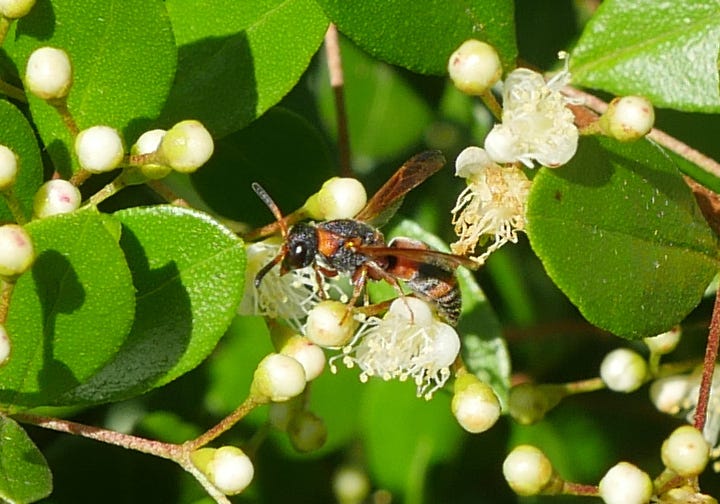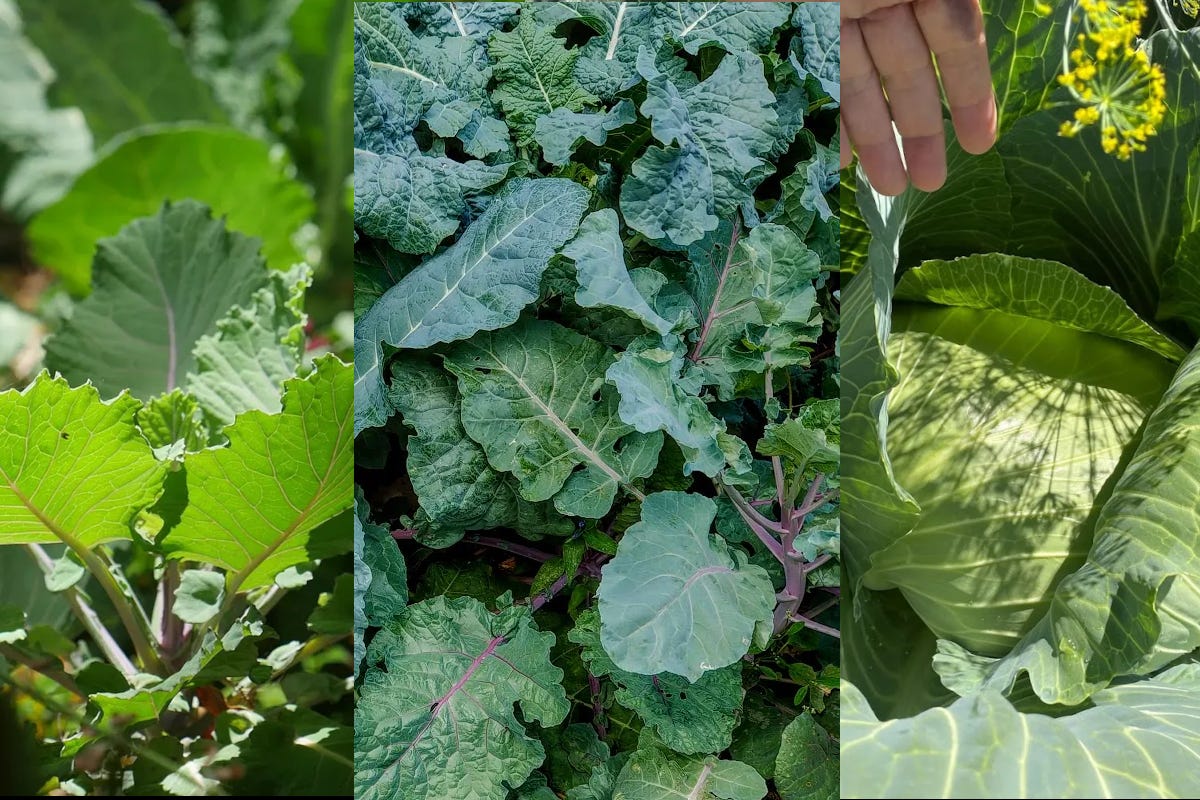Working with nature is a core principle of permaculture. One way to do this is by encouraging beneficial insects that can pollinate your garden and control pests. Some of them do both.
How do you encourage them? They need food and shelter. Both are relatively easy to provide, when you work with nature.
Many pest predators and pollinators are ground dwelling. They either shelter under leaves or other loose organic matter, or dig holes in bare dirt. It’s easy for a permaculturist to provide both of those things, but one thing they tend to have difficulty with is mulch, which permaculturists also love to use.
Many of the best pest predators like small flowers because either they are very small themselves, or they have small feeding mechanisms.
There is one plant in Florida that is a great solution for providing both food and shelter and that is the Simpson Stopper. It also happens to be a wonderful evergreen ornamental plant that looks great year-round, with small showy, fragrant white flowers and orange fruit. It is both drought and flood tolerant, thrives on low nutrient soils, grows in both sun and shade, sand or clay, and is frost hardy to at least 9A and some say, 8B or colder. It can be trimmed as a hedge or shaped as a small ornamental tree with showy bark.
What is not to love about this plant? We love it so much we’ve planted 10 in our food forest and are still planting more. We have occasionally fed it, but mostly leave it to its own devices. It has thrived on our farm in heat, cold, extreme drought and very wet weather, and looks great through it all.
And when it flowers - the pollinators come out in force! This lovely bush is literally covered with hundreds of pollinators on our farm, when in full bloom. And many of them are so very beneficial to our gardens!
This spring, I’ve been documenting the wild diversity of pollinators on our farm and there is no better place to do that than on our Simpson Stoppers.
The flowers started blooming on April 11th this year. In less than a week, we’ve documented well over 50 different types of native pollinators and are still counting. Many of these are wasps - something people are often taught to be afraid of. Perhaps you’ve been stung by a yellow jacket - many of us have. Most wasps, however, are the opposite of aggressive and many do not even have stingers (the males of many wasp species cannot sting at all - the females use their stinger to paralyze prey for their young). And they are incredibly useful, both as pollinators, and effective pest control.
Here are a few of the beneficial wasps we’ve seen since our Stopper started blooming:
Paper wasps - While intimidating, these wasps are not aggressive and don’t sting unless you step on one or trap it (hard to do). They make nests out of thin organic material like paper and sometimes do this on the side of your house or in an eave. People often kill them, though all you have to do is knock their nest down and they’ll rebuild elsewhere.
Their young eat many garden pests, specializing in larger pests like caterpillars, beetles and flies, while the adults pollinate flowers. We’ve seen one of these wasps dragging a caterpillar bigger than they are to their nest (such as a tomato hornworm), to feed their young. We’ve spotted at least 5 different kinds of paper wasps on the Stopper this week. We think they’re each attractive, in their own way.
The Four Banded Stink Bug wasp is one of our favorites. We think it’s beautiful, plus this wasp is in the “Sand Wasp” family which tends to love stink bugs, grasshoppers and other garden pests. They live in burrows in the sand and are not aggressive.
Mason and Potter wasps are quite the builders, many of them creating “pots” in soil some indigenous peoples may have modeled their pots after.
There are many types, most of which eat common garden pests. This small, non-aggressive wasp, a “Red Marked Pachodynerus,” eats armyworms. It is more than welcome in our garden!
The Ichneumonid wasps mainly eat caterpillars. They come in all sizes, large and small. Some smaller types are sold as pest control for crops; they’re very good at it. We saw this big guy, with the tongue twisting name of Gnamptopelta obsidianator, on a Stopper for the first time this year. We like the bright yellow antennae and red face. The female is all black. They eat grapevine caterpillars. Our Muscadine grape vines appreciate it.
This one, a Blue Mud-Dauber in the thread-waisted wasp family, has a beautiful blue flashy shine in sunlight and is especially fond of eating black widow spiders. He is definitely a welcome guest on our farm!
So while these wasps can look intimidating, they actually are big friends for your garden. Because we’ve encouraged both food and habitat for these big gorgeous guys, we have noticed a major drop off in pests (which were aggressive in our first years here - our garden was the most juicy food supply within miles).
We had aphids, white flies, destructive bugs and beetles, slugs, you name it. Kale and broccoli were chewed up. Now, I can neglect the garden and crops still look beautiful and healthy - often untouched by pests even during peak pest season.
And this is the result:
We also feed our soil and choose good cultivars for our region, but we do notice a big difference since we started supporting pest predators. We’ll continue to share our tips and tricks in future newsletters about this productive relationship with natural abundance and balance.
So happy gardening, and I hope you will embrace and welcome these beautiful, helpful, non-aggressive creatures, as we have! And plant a Simpson Stopper or two near your garden, which will bring the pest predators right where you want them with its fragrant blooms, when many pests hit their peak. This bush also brings in the butterflies and rare and beautiful moths.
Stay tuned for our next installment on pollinators!
How Do You Build Healthy Soil?
In this free, one-hour webinar, we’ll explore how to create and maintain rich, living soil using time-tested Permaculture methods. These techniques work with nature to build fertility, improve structure, and support long-term health—no synthetic fertilizers or chemical fixes required.
Grow Permaculture Curriculum and Courses:
Are you ready to take your next step in Permaculture? If so, we’ve got you covered from novice to all-star. Our our courses are under the direct supervision of Koreen Brennan, educator, diplomate, and PINA board member.
Online Permaculture Design Course
The internationally recognized Grow Permaculture Online Permaculture Design Course comes with hands-on practical and mentoring. Now more than ever, people have attention on creating more choices and resilience in their lives. We want healthy food, a clean environment, happiness and security for us, our children, and future generations. This course offers practical steps to achieving these things in your own life, regardless of your circumstances. You can get started right away! Sign up now!
In-Person Permaculture Design Course
This is Grow Permaculture’s internationally recognized In-Person Permaculture Design Course. This course will be held in St Petersburg, FL, and at our farm in Brooksville, giving people an opportunity to see permaculture in action on both the farm while also studying in an urban environment. Space is limited sign up today!
Check out our full lineup of Grow Permaculture Courses & Events!
Thanks for reading PermaLife! Subscribe for free to receive new posts and support my work.













